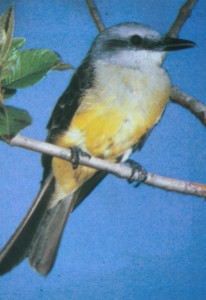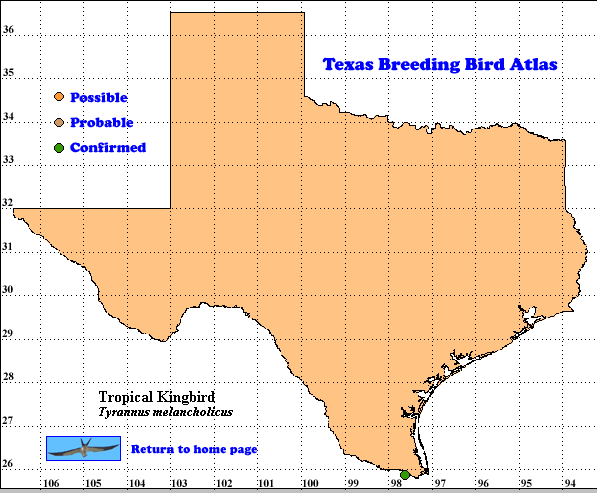Tropical Kingbird is a complex of populations spread from the southwestern United States to northern Argentina.These groups inhabit a variety of habitats. Couch’s Kingbird (Tyrannus couchii) was formerly included in this complex. Tropical and Couch’s kingbirds are very similar visually and are best distinguished by their vocalizations.
DISTRIBUTION. During the 1987-1992 field work of the TBBA project, volunteers found confirmed breeding evidence near Brownsville. Lockwood and Freeman (2004) report the species is also a permanent resident in Hidalgo County and has breed since 1997 at Cottonwood Campground in Big Bend National Park in Brewster County.
Outside Texas, the species breeds in scattered locations in southeast and central Arizona (Corman 2005), south through the lowlands of Middle America to South America where its range extends to Argentina (Stouffer and Chesser 1998).
SEASONAL OCCURRENCE.. Tropical Kingbird is a permanent resident in its limited breeding range in Texas (Lockwood and Freeman 2004).
BREEDING HABITAT. In Arizona where more habitat data has been gathered, Tropical Kingbirds breed in riparian vegetation, primarily cottonwood, willow and mesquite (Corman 2005).
The nest is built by the female of rootlets, fine twigs, herbaceous stems and dry grasses. The nest is a broad, shallow structure, often with dangling material which gives it an untidyappearance. It is sometimes thin enough for the eggs to be seen from below. The outside diameter is 11.5-16 cm (4.6-6.4 in), inside diameter 6.5-7.5 cm (2.6-3 in), depth 3-5 cm (1.2-2 in).
The female lays 2-4 slightly glossy, whitish, pale buff to pale pink eggs which she incubates for 15-16 days. The young birds are capable of strong flight by 18-19 days. Parasitism by Bronzed (Molothrus aeneus) and Shiny (M. bonariensis) cowbirds have been reported , but data are scanty (Stouffer and Chesser 1998).
STATUS. Lockwood and Freeman (2004) describe Tropical Kingbird as an uncommon and local resident in Texas. The North American Breeding Bird Survey does not sample this species in the United States well enough to provide range or trend data (Sauer et al. 2005).
Text by Robert C. Tweit (2005)
Literature cited.
Corman, T. E. 2005. Tropical Kingbird (Tyrannus melancholicus), pp. 326-327 in Arizona breeding bird atlas (T. E. Corman and C. Wise-Gervais). University of New Mexico Press, Albuquerque.
Lockwood, M. W. and B. Freeman. 2004. The TOS handbook of Texas birds. Texas A&M University Press, College Station.Sauer, J. R., J. E. Hines, and J. Fallon. 2005. The North American Breeding Bird Survey, results and analysis 1966-2004. Version 2005.1. USGS Patuxent Wildlife Research Center, Laurel MD (Web site, http://www.mbr-pwrc.usgs.gov/bbs).
Stouffer, P. C. and R. T. Chesser. 1998. Tropical Kingbird (Tyrannus melancholicus). In The birds of North America, No. 358 (A. Poole and F. Gill, eds.). The Birds of North America, Inc., Philadelphia, PA.

